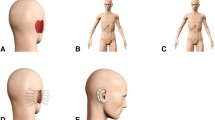Abstract
To evaluate and compare the scalp and the abdomen as split-thickness skin graft donor sites for aural stenosis repair. A total of 34 patients with aural stenosis were included in the study. All the patients underwent meatoplasty using split-thickness skin grafts. Among them, the skin graft donor site was the scalp in 11 patients and the abdomen in the other 23 patients. The surgical team followed the patients in the outpatient department for at least 6 months after surgery. Evaluations concerned healing of the donor site, hair regeneration of the donor site, survival of split-thickness skin grafts, reoccurrence of aural stenosis and hair growth in the ear canal. The incidences of reoccurrence of aural stenosis in the two groups were compared. Subjective scar evaluation of the donor sites was performed using the Patient Scar Assessment Scale (PASA). The scale items were pain, itching, color, stiffness, thickness and irregularity. All the scalp and abdominal donor sites healed well with no sign of infection. Hair regrowth and reepithelialization was observed at all the scalp donor sites. Pink discoloration was observed at the scalp donor sites in six patients 2–3 months after surgery and disappeared 6–9 months after surgery. Scars were observed at the scalp donor sites in two patients 6 months after surgery. No alopecia was observed at the scalp donor sites. The scars and pink discoloration were hidden in the hair. Scars and/or discoloration were observed at all the abdominal donor sites 12 months after surgery. All the scalp and abdominal skin grafts survived with no sign of infection. Hair growth was observed in the ear canals in two patients in the scalp group. The incidences of reoccurrence of aural stenosis were 0 % (0/23) in the abdominal group and 9.1 % (1/11) in the scalp group, respectively (Chi square test, p > 0.05). The PASA values about color, stiffness, thickness and irregularity were higher in the abdominal group than in the scalp group (Mann–Whitney U test, p < 0.001). The PASA values about pain and itching were the same (Mann–Whitney U test, p > 0.05). The scalp meets most requirements of an ideal donor site of skin grafts for aural stenosis. The advantages of scalp as a donor site include easy accessibility in the operative field, simple postoperative care, low risk of infection, rapid wound healing, minimal interference with rehabilitation, and minimal scar formation.







Similar content being viewed by others
References
Crawford BS (1964) An unusual skin donor site. Br J Plast Surg 17:311–313
Chang LY, Yang JY, Chuang SS, Hsiao CW (1998) Use of the scalp as a donor site for large burn wound coverage: review of 150 patients. World J Surg 22:296–299
Goldsztein H, Ort S, Roberson JB Jr, Reinisch J (2013) Scalp as split thickness skin graft donor site for congenital atresia repair. Laryngoscope 123:496–498
Draaijers LJ, Tempelman FR, Botman YA, Tuinebreijer WE, Middelkoop E, Kreis RW, van Zuijlen PP (2004) The patient and observer scar assessment scale: a reliable and feasible tool for scar evaluation. Plast Reconstr Surg 113:1960–1965 (discussion 1966–1967)
Mimoun M, Chaouat M, Picovski D, Serroussi D, Smarrito S (2006) The scalp is an advantageous donor site for thin-skin grafts: a report on 945 harvested samples. Plast Reconstr Surg 118:369–373
Barnett A, Berkowitz RL, Mills R, Vistnes LM (1983) Scalp as skin graft donor site: rapid reuse with synthetic adhesive moisture vapor permeable dressing. J Trauma 23:148–151
Weyandt GH, Bauer B, Berens N, Hamm H, Broecker EB (2009) Split-skin grafting from the scalp: the hidden advantage. Dermatol Surg 35:1873–1879
Lesesne CB, Rosenthal R (1986) A review of scalp split-thickness skin grafts and potential complications. Plast Reconstr Surg 77:757–758
Brou J, Vu T, McCauley RL, Herndon DN, Desai MH, Rutan RL, Stenberg B, Phillips LG, Robson MC (1990) The scalp as a donor site: revisited. J Trauma 30:579–581
Dardour JC, Noury-Duperrat G, Dufourmontel C (1977) Le cuir chevelu, zone donneuse des greffes minces. Ann Chir Plast 22:169
Jimenez F, Izeta A, Poblet E (2010) Morphometric analysis of the human scalp hair follicle: practical implications for the hair transplant surgeon and hair regeneration studies. Dermatol Surg 37:58–64
Ito M, Liu Y, Yang Z, Nguyen J, Liang F, Morris RJ, Cotsarelis G (2005) Stem cells in the hair follicle bulge contribute to wound repair but not to homeostasis of the epidermis. Nat Med 11:1351–1354
Durani P, McGrouther DA, Ferguson MW (2009) Current scales for assessing human scarring: a review. J Plast Reconstr Aesthet Surg 62:713–720
Mariani U (1988) Split skin grafts from the scalp. Rev Hosp Clin Fac Med Sao Paulo 43:267
Acknowledgments
We particularly thank Dr Ying Chen for her help in collection of clinical data. Sponsored by a New-Hundred-Brains Plan in Shanghai Health Care System (XBR2011068 2011.1-2013.12).
Conflict of interest
None.
Author information
Authors and Affiliations
Corresponding author
Rights and permissions
About this article
Cite this article
Du, Q., Zhang, T. Comparison of scalp and abdomen as split-thickness skin graft donor sites for aural stenosis repair. Eur Arch Otorhinolaryngol 271, 2159–2164 (2014). https://doi.org/10.1007/s00405-013-2710-y
Received:
Accepted:
Published:
Issue Date:
DOI: https://doi.org/10.1007/s00405-013-2710-y




